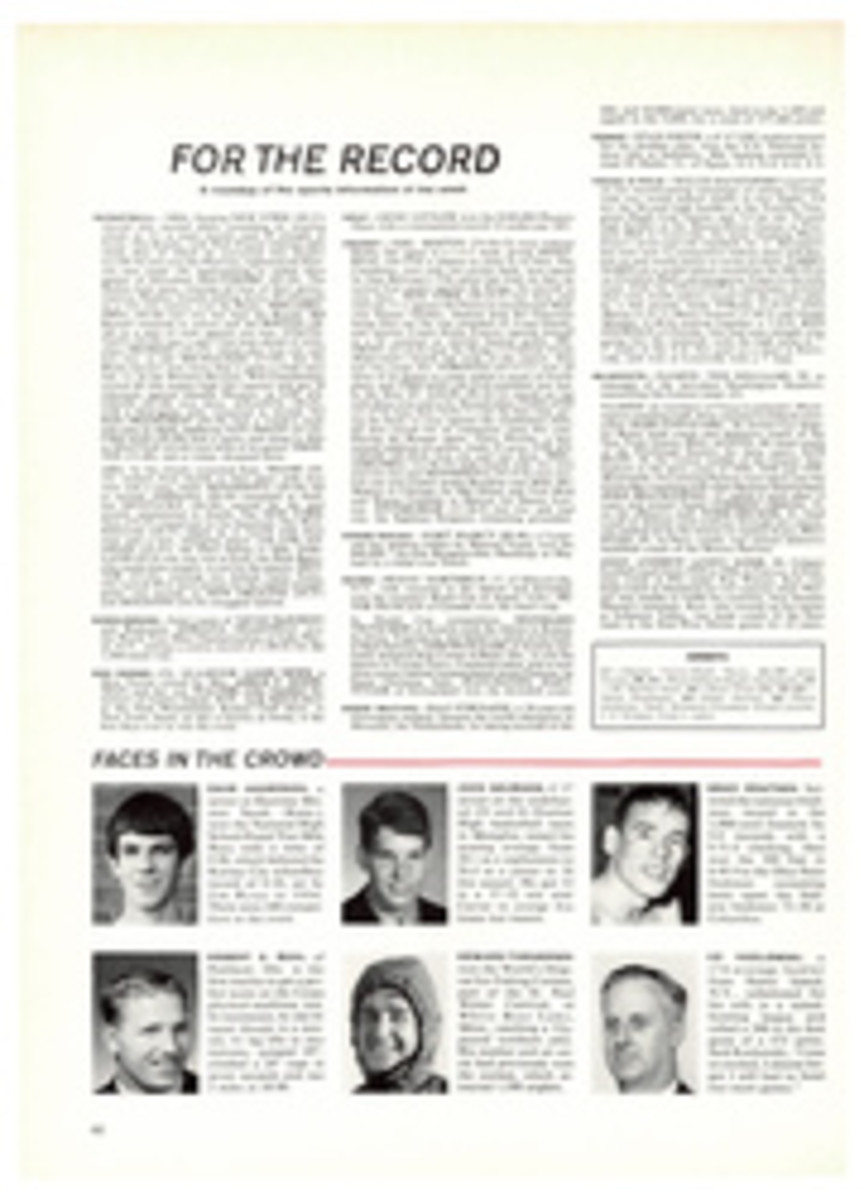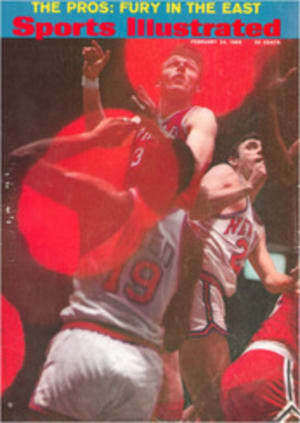
SCORECARD
TROUBLED OIL ON WATERS
The oil-slick disaster off Santa Barbara has revived memories of the wreck of the Torrey Canyon two years ago, when 100,000 tons of oil were discharged into the waters off the Cornish coast of England. Drastic efforts were made by the British to get rid of the runaway oil, including the application of vast amounts of detergent.
Today the damaged beaches are clean again—but antiseptically clean. There is no oil around, true, but little evidence of life, either, except for green-brown algae that flourish on the rocks along the shore. The algae are ordinarily controlled by small marine creatures like limpets that live in the littoral between low and high tides, but these were killed off in the disaster and are only just beginning to reappear. It apparently will take years for the old balance of nature to be restored.
The significant thing is that the cure was worse than the disease. That is, the detergents did much more damage to marine life than the oil did (birds, of course, were a different story; they were crippled and strangled by the oil). Although some marine breeding grounds were smothered and commercial fishermen were hurt because their catch began to have an unpleasant taste, marine life in general was not grievously damaged by the oil. Yet it was all but destroyed by the detergents. Along the shore, for example, 75% of the limpets survived on beaches hit by oil, but less than 10% were left on those oily beaches that were cleaned. Limpets and the like normally restrict the green-brown algae to about 28% of the rock surfaces along the Cornish beaches. On beaches that were damaged by oil but not treated with detergents, the algae have increased, but only to about 37%. On oil-damaged beaches that were treated, the algae population exploded and has spread to 86% of the rock area.
A British ecologist said recently, "If there should be another Torrey Canyon-type disaster, we really mustn't plaster detergent everywhere. When it does have to be used the affected areas should be washed down with sea water afterward."
Santa Barbara, please note.
REAL TIGER
Princeton beat Columbia a short while back in an Ivy League basketball showdown that aroused widespread interest. Late in the first half a phone rang on the press table in the Princeton gym, and a voice asked how the game was going. Told that Princeton had a three-point lead with a man on the foul line and two minutes to go in the half, the caller asked if he could stay on the phone for a personal play-by-play until the intermission.
"Sorry, we can't keep the line tied up like that," he was informed. "Why don't you listen to the game on the radio?"
"I can't," the fan said sadly. "I'm calling from Waco, Texas."
HOLY TOLEDO!
Jones Junior High is the best junior high in Toledo, as the old song says, and the Toledo Junior Blades are the best junior hockey team in the International Junior Hockey League. When regular-season play ended last week, the Junior Blades had a record of 24 wins, no losses and no ties, and they had scored 257 goals (the three other teams in the league combined scored only 285) to their opponents' 49. Toledo's average winning score was a walloping 11-2.
All of which, evidently, was extremely frustrating for Mike Mackintosh of third-place Dayton (eight wins, 15 losses, one tie). Although Toledo had six of the top 10 scorers, there was Dayton's Mackintosh in second place, and he was first in actually putting goals into the net (54 of his team's total of 94). Mike also led the league in penalty time, with 139 minutes in the 21 games he played. The top penalty total in the National Hockey League after more than 50 games this season was only 156 minutes, which means that on a percentage basis Mike Mackintosh is twice as mad as the maddest man in the NHL.
Sounds like a natural for the Boston Bruins, doesn't he?
TOO TRUE TO BE GOOD
We have been up to our ears in artificiality lately. We have had nylon-bubble field houses, AstroTurf and Tartan Turf fields, dyed golf traps and plastic weed beds. Now we have waterless boats. The hit of the London Boat Show this winter was a thing called the Power-Rider, built by Redifon Air Trainers, Ltd. It looks like a full-sized outboard motorboat, but it is actually a complex electronic toy controlled by a minisized analogue computer. It is a sort of super maritime version of those little mockup automobiles in amusement parks, the ones you have to steer over a filmed highway that comes at you on a movie screen. Instead of a highway, the Power-Rider faces a screen filled with a watery racecourse, complete with straightaways and curves and stretches of rough water. As you drive the course you get all the "big kick" sensation of powerboat racing—noise, speed, roll, pitch and planing or buffeting if the throttle is not reduced at the proper times. Throughout the ride you are serenaded by the sound of a 125-hp Mercury engine roaring out of two loudspeakers in the stern.
The ride, we are told, can be so rough that safety harnesses must be worn, and it is further reported that the experience is so true to life that some people get seasick. The Power-Rider apparently has achieved some sort of synthetic first: all the disabilities and none of the pleasures of boating.
ZATOPEK'S FATE
During the tragically brief period of freedom in Czechoslovakia, Emil Zatopek, the remarkable distance runner who won four gold medals and a silver at the 1948 and 1952 Olympic Games (including a unique 5,000-10,000-marathon sweep in 1952), spoke out with startling candor about the restrictive conditions that had hitherto prevailed in his country (SCORECARD, July 29, 1968). When night fell again in Czechoslovakia in August, little or nothing was heard about Zatopek. But a recent copy of a Czech weekly magazine called the Reporter carried a letter from Ludek Pachman, a noted chess player and mathematician, protesting Zatopek's demotion from the defense ministry to a post as assistant coach of an army track team in Prague. Pachman wrote: "I think many people in this land will agree that such status for a man who belongs to the most famous figures of the last quarter of a century is our joint shame, and I do not intend to bear this shame without protest."
Long live Emil Zatopek. Long live Ludek Pachman.
HOOKED HORN
In Texas former college students are seldom referred to as alumni. They are usually called ex-students, or exes for short. When Steve Fleming, a sought-after high school halfback, was asked why he had finally settled on the University of Texas he explained that his father and mother had gone there, that a cousin had played football there and that several other relatives had attended the university. "I guess," he concluded, "the ties of exes were upon me."
CONFRONTATION
No sooner had Baseball Coach Charles (Bobo) Brayton of Washington State scheduled a "trim-in" to keep his players, who began practice last week, from resembling one of those old House of David teams than English Professor Howard McCord retaliated in kind.
"I am requiring male students in English 452 (Creative Poetry) to allow their hair and/or beards to grow to suitably poetic lengths," wrote Professor McCord to the campus newspaper, The Daily Evergreen. "By this I hope they will feel more deeply a part of American poetry, following the hirsute tradition of such poets as Walt Whitman, Ezra Pound, Allen Ginsberg....
"But," added Professor McCord, "I think Professor Brayton's requirement is a dandy idea. It's a good device for creating and reinforcing a positive image...and preparing his players for the demands of the professional baseball world."
Coach Brayton was doubly pleased, first by the appellation of professor and second by the suggestion that his team had players with major league futures. He hustled over to McCord's office, and the two, meeting for the first time, hit it off splendidly. McCord showed Brayton a copy of his latest book of poetry, Long-jaunes His Periplus, and Brayton promised that his team would have a winning season. Then the pair posed amiably for photographers under a huge poster-photograph of Allen Ginsberg, with McCord, who had a rich growth of hair, holding a Louisville Slugger, and Brayton, whose head is as slick as a baseball, holding the book of poems.
HIGH COST OF HURTING
A recent article in Medical World News claims that medical expenses cost professional football teams more than $2 million a year. The magazine says that last season a team spent between $30,000 and $60,000 on hospital and doctors' bills, $20,000 for medical and disability insurance and $5,000 to cover the cost of tape, bandages and medication for relatively minor injuries. The teams also have to buy and maintain therapeutic devices, as well as pay the salaries of team trainers.
"Medical expenses are staggering," an NFL owner admitted, "but the biggest expense is paying the salaries of injured players who cannot perform. It probably comes to something like $3 million for both leagues."
That seems high (every team would have to have an average of four $30,000 players out of action in every game), but even so it seems reasonable to assume that the overall cost of injuries (plus an occasional head cold) runs well over $100,000 a team each season.
A rather depressing statistic, particularly if you metamorphose the dollar signs into images of Gale Sayers being carried off the field, Larry Bowie being operated on for a blood clot on the right side of his brain, Les Josephson going out for the season with a torn Achilles' tendon.
Several studies of injuries are being made—with an eye to finding how most, of them are caused and how they can be reduced in number and severity—but some pro football people have expressed little interest. "Football is a rough game," said one owner, "but, heck, I lost more games to the Hong Kong flu than I did to brittle knee joints. What should we do—eliminate tackling so that the fellows don't spread germs?"
This rather inane comment conveniently ignores the central problem, and it also shows a certain insensitivity to the financial agony of stockholders: As one team physician remarked: "If the Neanderthals in this game turn their backs on research results, they're just begging to get clipped."
NOT MY BAG
For the rugged outdoor man, the Woods Bag and Canvas Company of Ogdensburg, N.Y. has developed a sleeping bag that costs $750. The bag contains 4¼ pounds of eiderdown, a cashmere lining and a zip-in Hudson Bay blanket. The hood is mouton hide, and the ruffle around the hide is northern wolf.
"We built it mostly as a show stopper," said a man at the National Sporting Goods Association convention in Houston, "but we've sold a few. Most of them have been gifts to the man who has everything."
Naturally. It's obvious that this is not the average hunter's bag.
ILLUSTRATION
THEY SAID IT
•Howie Dallmar, Stanford basketball coach, on Lew Alcindor's devastating length-of-the-court passes: "They're tough to stop. It's like rushing the passer in football. You don't know whether to go in after Alcindor or drop people back like linebackers to cover his receivers."
•Al Davis, general manager of the Oakland Raiders, the AFL's Western Division champions, after the pro football draft: "I'm not sure this socialized system is best. It doesn't seem fair to penalize a team for winning. If you can't win the championship, you're better off doing what Buffalo did—finish last and get the first pick."

